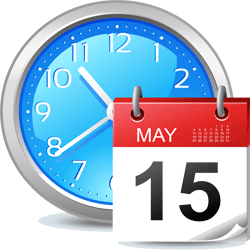 Do you wish you had the ability to add more time to your day?
I do.
Do you wish you had the ability to add more time to your day?
I do.
However, as I cannot create more time (at least not yet), I read books about how to increase and maximize my productivity.
I have read a fair number of productivity books over the years and recently I noticed that they all offer the same formula for success; authors just use different jargon to convey the same productivity recipe.
In this post, you will discover the blueprint offered in nearly every productivity book.
Blueprint for Increased Productivity
The formula for increasing and maximizing your productivity consists of 6 Steps:
Step 1: Create goals.
Dream about your life.
What would you like to accomplish? Where would you like to live? What kind of relationships would you like to forge?
Think about every aspect of your personal and professional life and note your hopes and dreams.
Step 2: Write down your goals and internalize them.
After you think about what you want to accomplish and what you want your life to be like, write down your ideas.
Read and refer to your written goals often. Visualize yourself realizing your goals as you review them. If you internalize your goals and believe that you will accomplish them then you will find ways to achieve them.
 Step 3: Break your goals down into actionable steps.
Step 3: Break your goals down into actionable steps.
Create an action plan.
What work do you need to do to achieve your goals?
Outline this work and use this sketch to plot out actionable steps that you can take to realize your goals.
Step 4: Review and plan progress weekly, monthly, and quarterly.
Life goals tend to require a lot of action steps to achieve. The sheer number of steps it might take for a person to realize their dreams discourages most from trying. Overcome this mental barrier.
Break down the number of action steps you need to take by plotting out how you will undertake a portion of those steps each quarter.
Divide the steps you plan to accomplish within each three-month period among each month in the quarter.
Distribute the work you will tackle within a month among each week within that month.
By dividing your action steps into manageable steps and time frames you will make incremental progress toward your larger goals.
Step 5: Tell people about your goals and your progress.
Hold yourself accountable for progress by telling people about your dreams.
You will make the most progress toward achieving your goals if you know people are counting on you or that they will ask you about your progress.
 Step 6: Maintain focus by writing down ideas and tasks.
Step 6: Maintain focus by writing down ideas and tasks.
Maintaining focus can be hard. Free up mental space by writing down ideas, tasks, and other important thoughts in a safe place. Your mind will let go of these ideas once it knows that you have filed them in a place where they won’t be lost.
Each week, month, and quarter, review the ideas and thoughts you stored and sort them into your action plan. If the ideas don't align with your larger goals, file them away for “later” and let the ideas rest.
Conclusion
The above six steps appear in nearly every productivity book. Authors call each step something different to make their book stand out, but their advice represents a variation of the same success formula.
The key to their advice: you can achieve almost anything if you make steady, incremental progress and persist in your desire to reach your goals.
Now that my brain has recognized this productivity recipe, I won’t be reading any more productivity books. Instead, I will will divert my energy toward accomplishing the tasks in my action plans and to reading other books on my to-read list.
 Share Your Story
Share Your Story
What are your favorite productivity tips?







